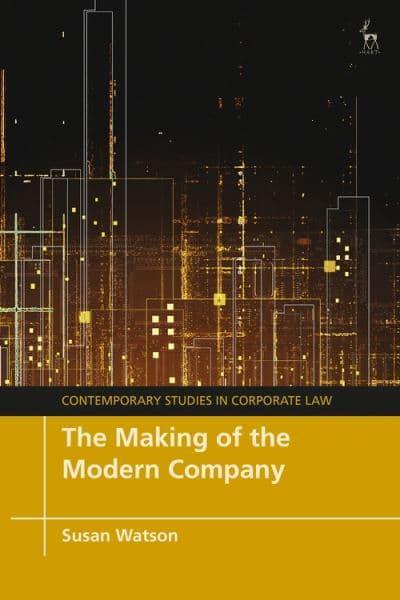The making of the modern company
- ISBN: 9781509923625
- Editorial: Hart Publishing
- Fecha de la edición: 2023
- Lugar de la edición: Oxford. Reino Unido
- Colección: Contemporary Studies in Corporate Law
- Encuadernación: Cartoné
- Medidas: 24 cm
- Nº Pág.: 336
- Idiomas: Inglés

This book adopts a historical perspective to highlight, and bring back into focus, the key features of the modern company. A central argument in the book is that legal personhood attaching to an entity containing a corporate fund seeded by shareholders is a direct and inevitable consequence of limited liability and the company's status as a separate legal entity from its shareholders. Management by a board subject to legal duties to the company as an entity that can exist in perpetuity facilitates a long term perspective by the board that can accommodate both shareholder and stakeholder interests. These defining characteristics differentiate the modern company from other business forms. The Making of the Modern Company applies a 21st-century lens to the corporation through its history to identify turning points in its development. It sets out how key features emerged in the course of two separate developmental cycles in English corporate law: first with the English East India Company in the 17th century, and then with general incorporation statutes in the 2nd half of the 19th century. The book's historical perspective highlights that the key features are part of the 'secret sauce' of modern companies. Each cycle coincided with unparalleled periods of economic success associated with corporate activity This book will be of interest to corporate law and governance academics, theorists and practitioners, those who study the company from related disciplines, and anyone who questions why uncertainty still exists about the structure of a legal form that has been described as 'amongst mankind's greatest inventions'.
1. Introduction
I. Introduction
II. Key Features
III. Property versus Social Entity
IV. The Agency Problem
V. The Making of the Modern Company
PART ONE
DEVELOPMENT OF THE MODERN COMPANY
2. Persona Ficta and Joint Stock
I. Two Kinds of Legal Organisation
II. Early Corporate Enterprises
III. Early Funds
IV. Contractual Joint Stock Companies
V. Business Corporations
VI. Separate Legal Entity
VII. Persona Ficta
VIII. Conclusion
3. The Transition to Permanent Capital in the English East India Company
I. Introduction
II. The First Twenty Years
III. The Second Twenty Years
IV. The Third Twenty Years
V. The 1657 Charter
4. Corporate Governance in the English East India Company
I. Introduction
II. Development of Governance Structures in Early Business Corporations
III. Shareholder Activism in the English East India Company
IV. Maurice Thomson and the Emergence of Directors' Duties
5. The Rise and Fall of the English East India Company
I. The English East India Company with Permanent Capital
II. The Impact of the Legal Structure
III. Private Trade in the English East India Company
IV. The Fall of the English East India Company
V. Conclusion – The English East India Company in Context
6. The Early Emergence of Directors' Duties
I. Introduction
II. Emerging Obligations of the Governing Body of the English East India Company
III. Role of the Oath in the Obligations of Governing Bodies
IV. Charitable Corporation v Sutton
V. Development of Duties Around Conflict of Interest
7. Liability of Shareholders of Business Corporations
I. Introduction
II. Liability of Shareholders to Third-Party Creditors
III. Could Shareholders be Compelled to Contribute Capital to the Company?
IV. Shift in Focus to the Contractual Joint Stock Company
8. The Significance of the Deed of Settlement Company
I. Introduction
II. The Bubble Act
III. The Deed of Settlement Company
IV. The Efficacy of the Deed of Settlement Company
V. The Business Corporation in the Eighteenth Century
VI. The Relative Adoption of the Two Corporate Forms
VII. Corporate Governance in Deed of Settlement Companies
VIII. Conclusion
9. General Incorporation Statutes
I. Introduction
II. The Joint Stock Companies Act 1844
III. The Joint Stock Companies Act 1856
IV. Limited Liability
V. Was the Modern Company a Partnership or a Corporation?
VI. Salomon v Salomon & Co Ltd
10. Key Milestones in the Development of the Modern Company
I. Introduction
II. Double-Entry Bookkeeping
III. The Floating Charge
IV. Company Law
V. The Significance of Salomon
VI. Conclusion
PART TWO
CONSEQUENCES OF THE MODERN COMPANY
11. England Compared with Other Jurisdictions
I. Introduction
II. United States and Germany Compared with England
III. 'Quaker' Companies
IV. The Early US Corporation
V. Germany
VI. Conclusion
12. The Transition to the Modern Company in England
I. Introduction
II. Slow Adoption of the Corporate Form
III. Financing Structure
IV. Financing after the General Incorporation Statutes
V. Contemporaneous Commentary on English Financing of Companies
VI. The Private Company
VII. Founders and Families Retaining Control
VIII. Delays in Management Power Shifting from Shareholders to the Board
IX. Conclusion
13. Conceptions of the Components and Characteristics of the Company
I. The Corporate Fund and Entity Shielding
II. The Corporate Fund in History
III. The Corporate Fund and Creditors
IV. The Corporate Fund as a Concept
V. Understanding the Corporate Fund through the Floating Charge
VI. Property Rights in the Company
VII. Conceptions of the Company
VIII. The Nature of Legal Personhood
IX. The Modern Company as a Legal Fiction
X. The Persona Ficta Modified
XI. The Significance of the Persona Ficta
XII. Separate Legal Entity and Legal Personhood
XIII. Conclusion
14. The Modern Company as an Entity
I. Introduction
II. The Role of Real Entity Theory
III. The Contribution of Real Entity Theory to the Understanding of the Modern Company
IV. The Modern Company as a Real Entity
V. The Persona of the Corporate Entity
VI. The Modern Company as a Firm
VII. The Modern Company as an Organisation
VIII. The Modern Company as an Entity
IX. The Accounting Entity
15. Corporate Governance
I. Introduction
II. Are Directors the Legal Agents of Shareholders?
III. Are Directors the Economic Agents of Shareholders?
IV. Berle and Means
V. Entity Primacy
VI. Should Companies Maximise Wealth for Shareholders?
VII. Obligations of Directors
VIII. Operationalising Entity Primacy
IX. Conclusion
16. The Modern Company: Perils and Potential
I. Corporate Morality
II. Sustainability Realised
III. Personal Capitalism
IV. The Modern Company







